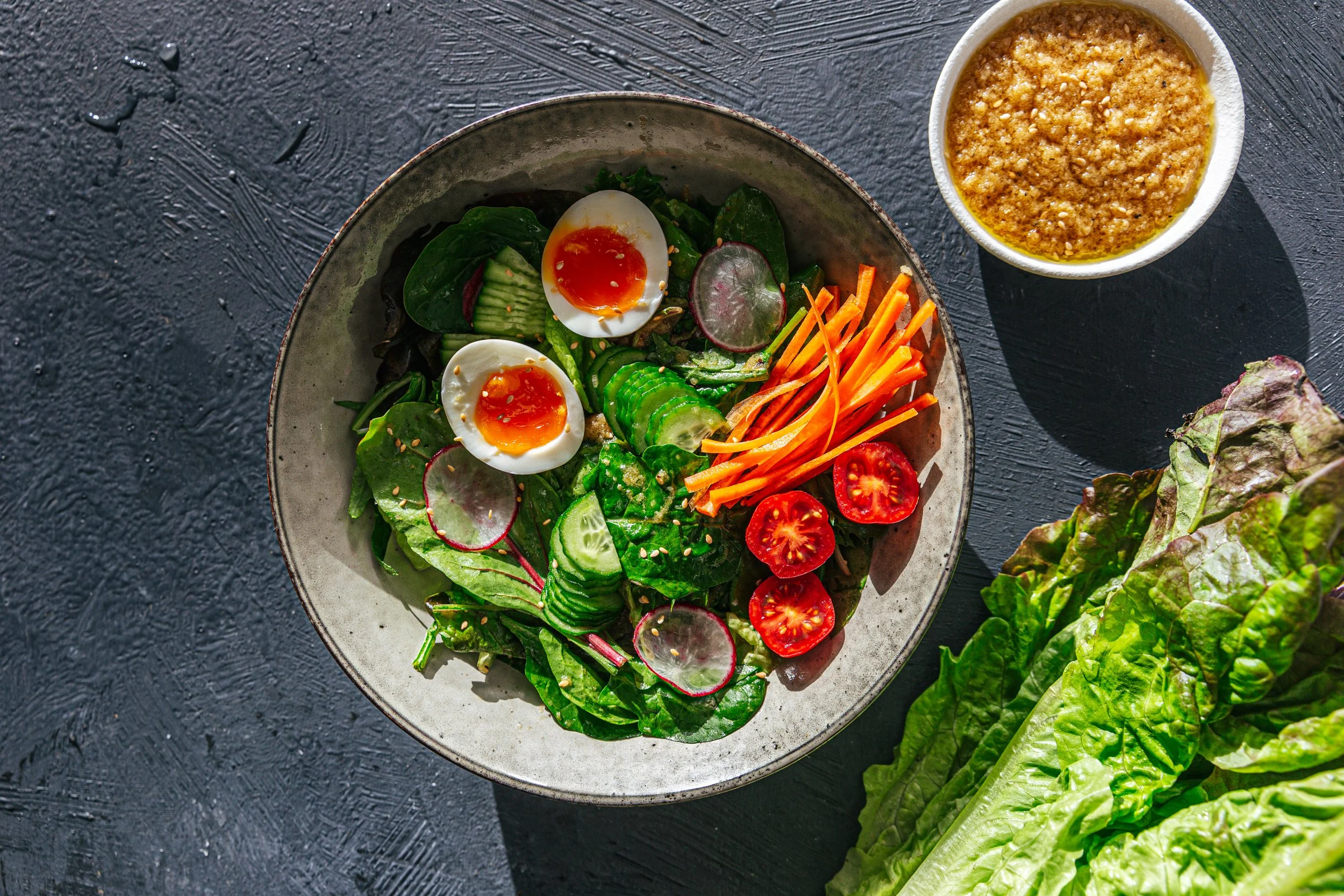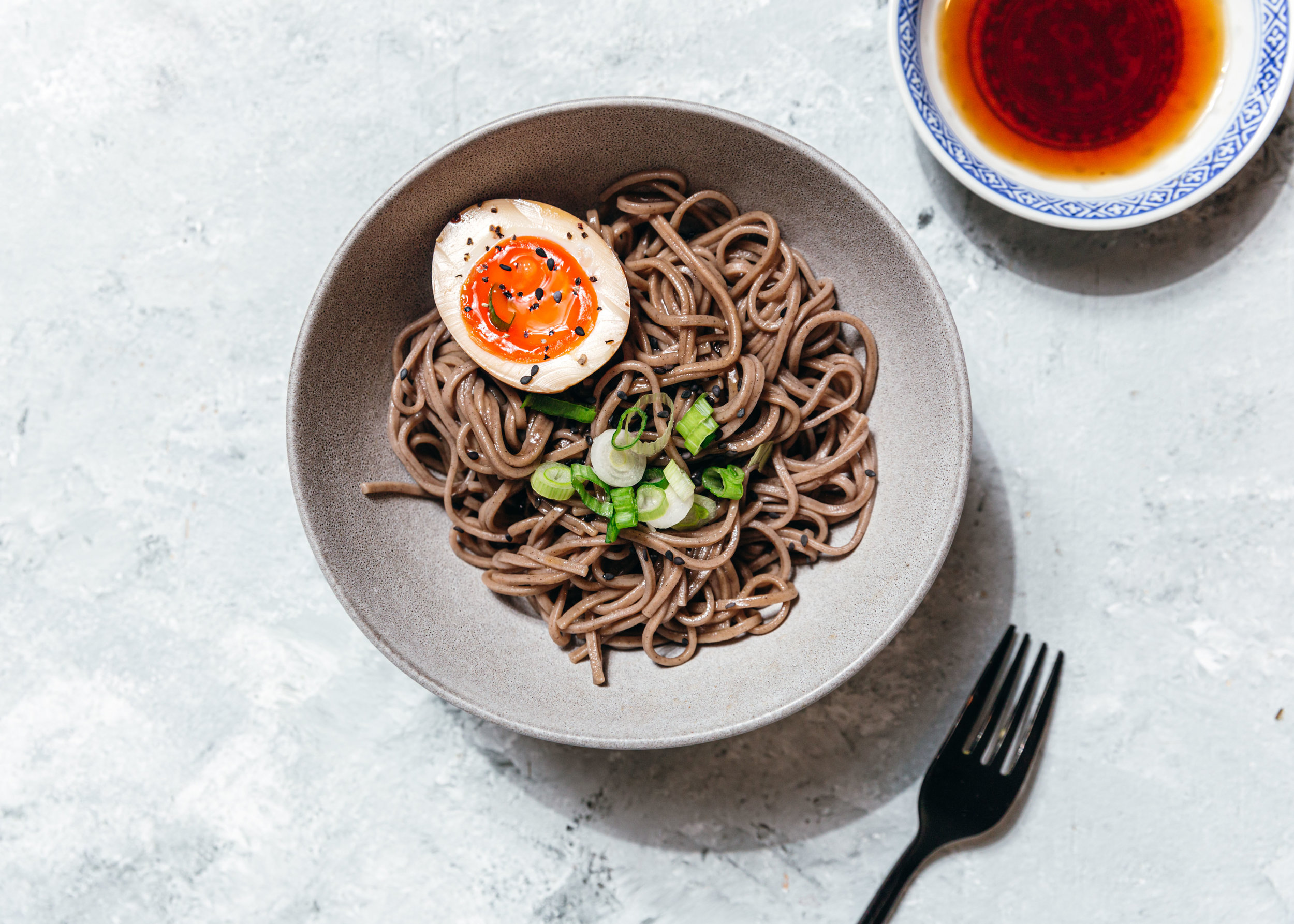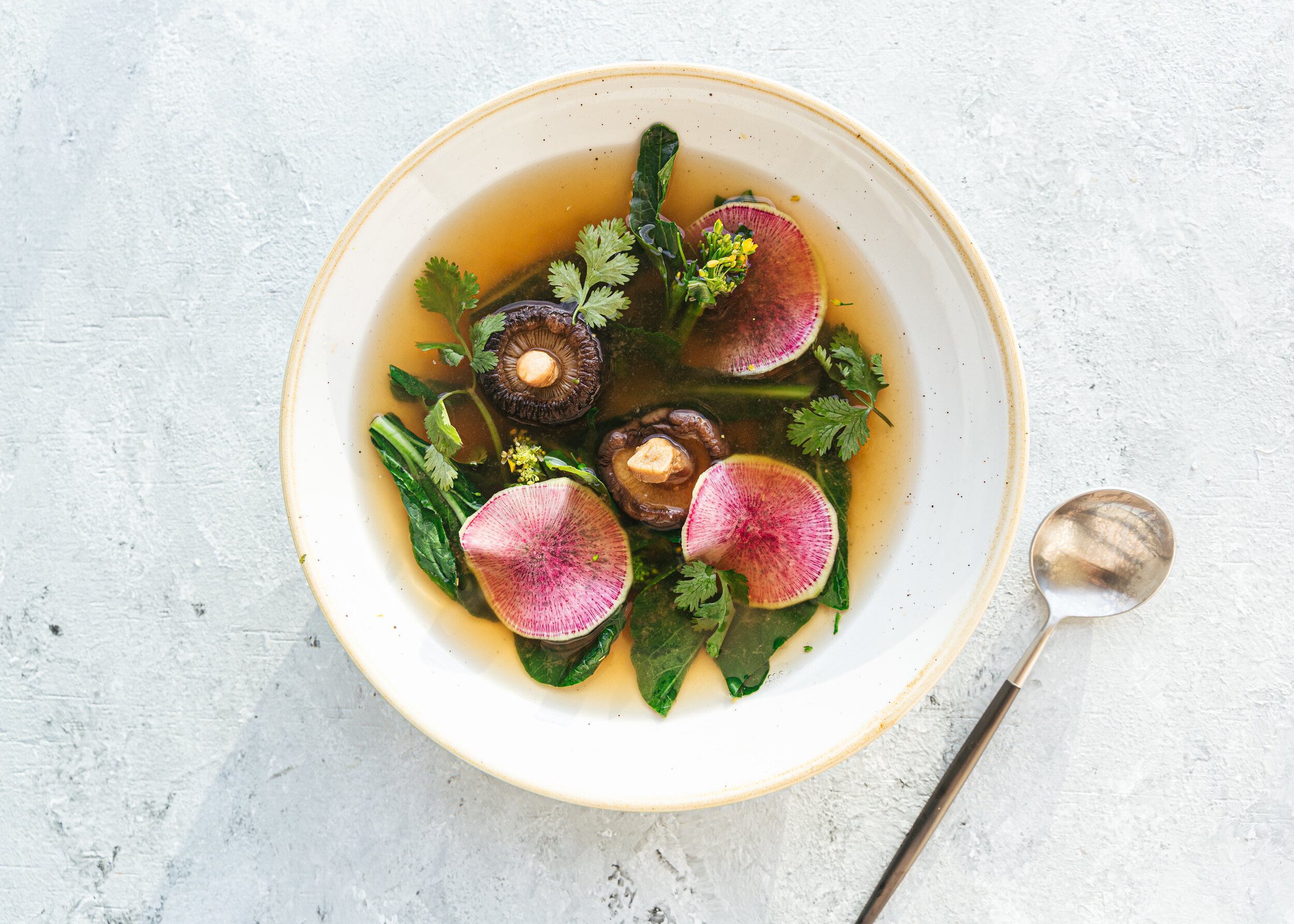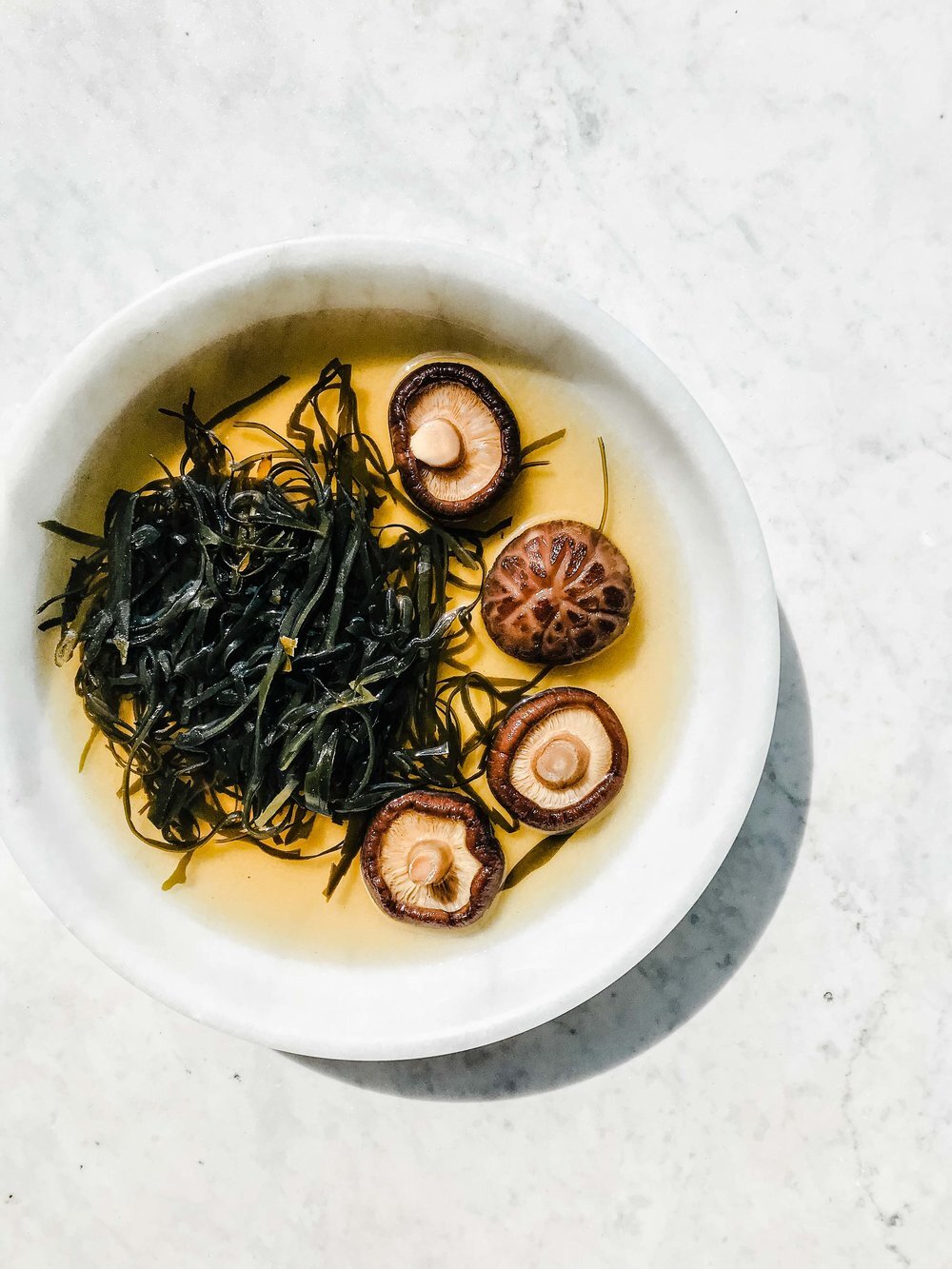In Chinese culture, lotus root is described as “the lover’s vegetable”. There are strands of fibre that connect every piece as you take a bite. In short, a sentimental vegetable that is unwilling to part with itself. Stewed in broths, thrown in stir-fries and pickled for salads — I’ve loved poking my chopsticks through the holes to eat as a child. It’s a vegetable that is rewarding to work with and fun to introduce to your friends.
Read MoreJapanese Onion Salad Dressing (Wafu)
Wafu (和風) is a popular Japanese salad dressing which is basically an onion vinaigrette. It takes 5 ingredients to make and pairs perfectly with greens, lettuce, cucumber for an appetizer or a refreshing side.
This dressing brings me back to my high school days when I worked at Mos Burger — a Japanese chain restaurant that specializes in rice burgers. Boy, I loved everything on the menu — fish fillets, pomelo ice teas, organic rice patties (some of my coworkers used them to make fried rice). It was a memorable and delicious time.
Among their menu, Wafu salad was a bestseller. It had completely slipped my mind until I came across it on Adam Liaw’s social media. Making it brings me back to the school days — walking home after an evening shift, the jasmine-scented gardens of Chang Kai Shek memorial hall, koi fish ponds, and the many meals I shared with my friends. I will be eating lots of Wafu dressing on salads this summer.
Japanese Onion Salad Dressing (Wafu/和風醬)
Ingredients
1/2 onion, roughly chopped (around 1 cup)
1 tbsp soy sauce
2 tbsp rice vinegar (sub-seasoned rice vinegar and omit the sugar)
1 tbsp cane sugar
1/2 cup grapeseed oil (sub olive oil)
1/2 tbsp toasted sesame seeds (optional)
Instructions
Add all of the ingredients aside from the oil into a blender or food processor. Pulse and blend into a thick dressing. Don’t overblend.
Top with oil of choice and sesame seeds. Seal the jar, and give it a good shake until the ingredients emulsify. Serve over salad or soba/rice noodles. Dressing keeps for 3-4 days in the fridge
Cooking Notes:
• Traditionally, the onions are grated with a Microplane grater to preserve texture. I find the blender method easier with limited time on my hands.
• If making beforehand, give the dressing jar a good shake before serving.
How to make Totoro Soba Noodles
I came across this idea on @iamafoodblog’s post and cannot look at these photos without feeling overwhelming happy on the inside. These Totoro’s were eaten with most reluctance and they were a ton of fun to make. If you’re hosting, it’s a great way to entertain your guests by handing them a pair of scissors, a nori sheet, a slab of mozzarella cheese and setting them to work.
I love the simplicity of Japanese recipes made with few but good ingredients. These soba noodles take less than six ingredients to put together but are so satisfying and light. Paired with ramen egg — it’s going to be a repeat meal in my kitchen.
Totoro Soba Noodles
You will need:
Noodles/Totoro Body:
Buckwheat soba noodles
White somen noodles
Sliced mozzarella cheese (for eyes)
Nori sheet
Dashi sauce:
Green onions, sliced
Dashi powder 1 tbsp ( i use Hondashi, found in T&T)
Soy sauce 1 tbsp
Water 1/4 cup
Mirin, 1 tsp
Sesame oil, to taste
1. Prep the Totoro eyes, nose, whiskers.
2. Cook noodles. Follow cooking instructions on the package or here.
Somen: Bring 6 cups of water to boil. Throw in a bundle of noodles, stir and set the timer for 3 minutes. Taste test them for doneness. Drain hot water with a strainer and rinse repeatedly under cold water until the water runs clear. This will prevent your noodles from sticking together.
Buckwheat soba: Same instructions as somen but set the timer for 6 minutes.
3. Combine and stir dashi powder, soy sauce, water and mirin in a bowl. Taste for flavour. The sauce should be very salty.
4. Form Totoro body with buckwheat noodles, using white somen for the abdomen, cheese for eyes and nori to top.
5. To serve: drizzle dashi sauce over noodles. Add a sprinkle of sesame oil, sesame seeds. Garnish with green onions. Serve with a ramen egg if you have one on hand. Enjoy.
If you have a lot of time on your hands, here is an old recipe for Totoro Rice cakes.
Miso Soup with Yu Choy and Dashi Stock
I bought a bag of shiitake mushrooms for vegetarian dumplings the other day and was left with an abundance of dried mushrooms. I have never cooked with shiitake mushrooms till recent and they remind me of street food in Taiwan and a lot of my mother’s cooking.
I remember savouring these explosions of flavour in chicken broths, in the mountains of fried rice noodles grandmother would make when we visit, and in the sticky rice steamed in bamboo leaves during festivals. I also remember being made fun of in elementary school because my classmates told me they looked like tiny slugs. Not to be deceived by looks — these mushrooms are essential to Asian cuisine and can be found in hot pots, stir fry and everything savoury. Something I proudly stock in my pantry nowadays.
Here is a recipe for miso soup using a very simple dashi stock. The watermelon radish serves more as a garnish but adds such a beautiful touch.
My apologies in advance for the abstractness of this recipe, I hope you taste as you go and refrain from taking too many photos as I’ve let food burn in the process. I enjoy serving this soup as an attractive appetizer or for evenings when I want something light and warm. For friends or myself.
Serves 4
Ingredients:
Dashi stock
5–6 Dried shiitake mushrooms
Handful of dried kombu (2-3 slices or half a cup if they are sliced)
1. Lightly rinse shiitake mushrooms. Do not wash kombu as the white residue adds flavour. Wipe kombu with a paper towel if you wish.
2. Fill a jar with two cups of water, soak the mushrooms and kombu. Seal and let sit for a few hours or overnight. The stock keeps well so you can make it a few days in advance
Miso Soup
Medium-firm tofu, one package, cut into blocks
Handful of baby yu choy
Miso paste, 3-4 tablespoons
Ginger, 2 slices
Soy sauce, to taste
Watermelon radish, sliced as thin as possible (use a mandolin)
Coriander or arugula, for garnish
Instructions
1. Remove mushrooms from slice into pieces. Discard the stem if you find them tough. Wash baby yu choy and chop into 2-inch pieces. Save some of the flowering tops for garnish. Cut tofu into small squares.
2. Heat the dashi stock and ginger in a pot till it comes to a simmer. Add miso paste and stir to taste. Add tofu to the pot until it boils. Taste the soup, add a few drops of soy sauce if it needs more flavour. Stir yu choy stems in till it comes to a boil again. Add the leafy parts to the soup at the last possible minute.
3. Garnish with sliced radish and coriander. Serve immediately.
Notes: I have found that arugula is a fantastic addition to miso soup. Feel free to substitute baby yu choy with other greens. I have started adding dried anchovies to the soup though the additional taste of fish may not be for everyone.
The Easiest Kombu Dashi Recipe
Here is a recipe for a tasty vegetarian broth made from Kombu (kelp) and shitake mushrooms. Kombu is one of those things that are full of minerals and really good for you. Something my mother always tells me to eat. I would use this in place of vegetable stock, add to chawanmushi (steamed egg curd), or use as a base for miso soup.
When I lived in Northern China, I often saw older ladies and aunties harvesting bundles of green seaweed by the sea. They earned the title “Sea Women” from the locals which I found rather amusing. Those trips to the fish market were quite exotic and I remember seeing starfish, the tiniest river lobsters, and spangled-looking fish. I think of those days with fondness, and laugh at how I tried to cook lobsters in my dorm room. Making these recipes make me recall a lot of the shabu-shabu (Japanese hot pot), light broths and dishes I had growing up in Taipei.
Ingredients
5-6 dried shitake mushrooms, rinsed
A handful of Kelp (wipe clean with a paper towel gently, do not rinse)
Instructions
Add ingredients with 2-3 cups of water in jar or container. Leave to soak for a few hours. I keep mine in the fridge overnight. Discard the kombu but you can slice and add the shitake mushrooms into the soup.
*Add bonito flakes for a richer, non-vegetarian broth. I made the mistake of washing my kombu for the first time and realized the white residue on top is what brings the umami flavour to the soup. You can wipe the kombu gently with a paper towel instead of rinsing it.











